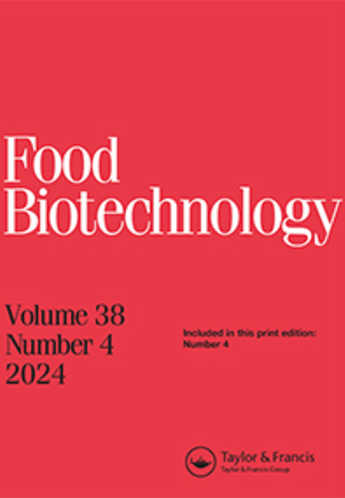通过体外消化和发酵,评价枯草芽孢杆菌发酵山葵作为功能性食品原料的潜力
IF 1.6
4区 农林科学
Q4 BIOTECHNOLOGY & APPLIED MICROBIOLOGY
引用次数: 5
摘要
摘要:本研究采用体外消化和发酵的方法模拟发酵后的冈菜的消费过程,从而评估其作为功能性食品成分的潜力。这是为了开发一种不产生二次废物的利用okara的方法。发酵使可溶性膳食纤维的含量提高了187%。氨基酸、脂肪酸和维生素K2 MK-7的生物可及性在发酵豆渣的消化上清液中较高。枯草芽孢杆菌在消化后也能存活。发酵后的上清液在小肠和大肠中具有较高的总酚含量的生物可及性和较高的DPPH自由基清除活性。同样,乙酸、丙酸和丁酸的浓度分别高出44.4%、46.9%和51.8%。在发酵和未发酵的豆渣发酵上清液中,肠道微生物群也存在差异。结果表明,发酵豆渣具有作为功能性食品原料的潜力。本文章由计算机程序翻译,如有差异,请以英文原文为准。
Evaluating the potential of Bacillus subtilis fermented okara as a functional food ingredient through in vitro digestion and fermentation
ABSTRACT In this study, in vitro digestion and fermentation was employed to simulate the consumption of fermented okara and hence, evaluate its potential as a functional food ingredient. This is to develop a method of utilizing okara without producing secondary waste. Fermentation increased the amount of soluble dietary fiber by 187%. Bioaccessibility of amino acids, fatty acids, and vitamin K2 MK-7 is higher in the digestion supernatant of fermented okara. Bacillus subtilis also remained viable after digestion. Supernatants of fermented okara exhibited higher bio accessibility of total phenolic content and higher DPPH radical scavenging activity in the small and large intestines. Similarly, the concentrations of acetic acid, propionic acid, and butyric acid were 44.4%, 46.9%, and 51.8% higher, respectively. The gut microbiota was also found to be different in the fermentation supernatants between fermented and unfermented okara. Results demonstrated the potential of fermented okara as a functional food ingredient.
求助全文
通过发布文献求助,成功后即可免费获取论文全文。
去求助
来源期刊

Food Biotechnology
工程技术-生物工程与应用微生物
CiteScore
3.80
自引率
0.00%
发文量
15
审稿时长
>12 weeks
期刊介绍:
Food Biotechnology is an international, peer-reviewed journal that is focused on current and emerging developments and applications of modern genetics, enzymatic, metabolic and systems-based biochemical processes in food and food-related biological systems. The goal is to help produce and improve foods, food ingredients, and functional foods at the processing stage and beyond agricultural production.
Other areas of strong interest are microbial and fermentation-based metabolic processing to improve foods, food microbiomes for health, metabolic basis for food ingredients with health benefits, molecular and metabolic approaches to functional foods, and biochemical processes for food waste remediation. In addition, articles addressing the topics of modern molecular, metabolic and biochemical approaches to improving food safety and quality are also published.
Researchers in agriculture, food science and nutrition, including food and biotechnology consultants around the world will benefit from the research published in Food Biotechnology. The published research and reviews can be utilized to further educational and research programs and may also be applied to food quality and value added processing challenges, which are continuously evolving and expanding based upon the peer reviewed research conducted and published in the journal.
 求助内容:
求助内容: 应助结果提醒方式:
应助结果提醒方式:


